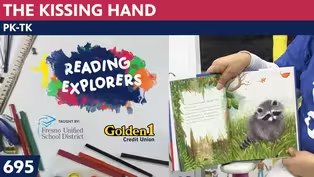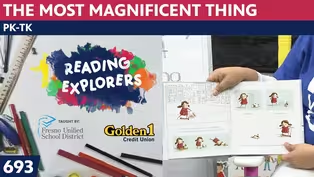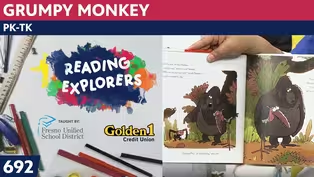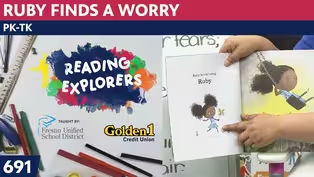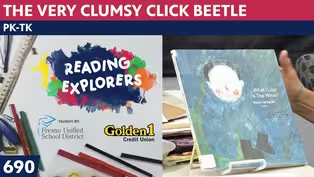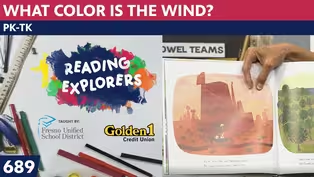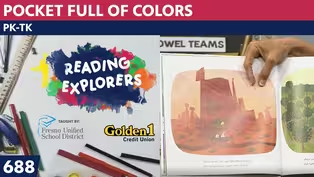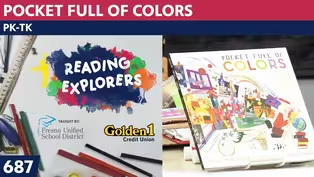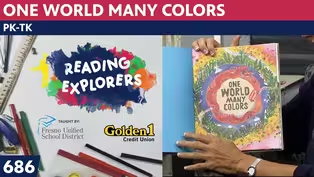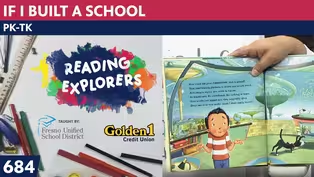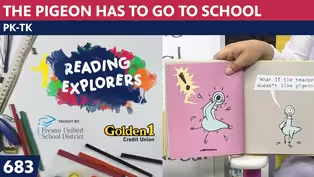
TK-333: Marc Chagall
Season 3 Episode 174 | 14m 13sVideo has Closed Captions
Join Mrs. Readwright at Camp Discovery!
Transitional Kindergarten teacher, Mrs. Readwright, welcomes students back to Camp Discovery, a fun learning space packed with reading adventures & fun games!
Problems playing video? | Closed Captioning Feedback
Problems playing video? | Closed Captioning Feedback
Reading Explorers is a local public television program presented by Valley PBS

TK-333: Marc Chagall
Season 3 Episode 174 | 14m 13sVideo has Closed Captions
Transitional Kindergarten teacher, Mrs. Readwright, welcomes students back to Camp Discovery, a fun learning space packed with reading adventures & fun games!
Problems playing video? | Closed Captioning Feedback
How to Watch Reading Explorers
Reading Explorers is available to stream on pbs.org and the free PBS App, available on iPhone, Apple TV, Android TV, Android smartphones, Amazon Fire TV, Amazon Fire Tablet, Roku, Samsung Smart TV, and Vizio.
Providing Support for PBS.org
Learn Moreabout PBS online sponsorshipMore from This Collection
Valley PBS and Fresno Unified School District have partnered with Golden 1 Credit Union to create Reading Explorers Lessons for grades Pre-Kindergarten through Third grade. The daily lessons will be taught by Fresno Unified School District teachers and are created to help students practice their reading skills and reinforce lessons during distance learning.
Video has Closed Captions
Valley PBS presents Reading Explorers Lessons for Pre-Kindergarten and TK. (26m 27s)
PK-TK-693-The Most Magnificent Thing
Video has Closed Captions
Valley PBS presents Reading Explorers Lessons for Pre-Kindergarten and TK. (26m 26s)
Video has Closed Captions
Valley PBS presents Reading Explorers Lessons for Pre-Kindergarten and TK. (26m 28s)
Video has Closed Captions
Valley PBS presents Reading Explorers Lessons for Pre-Kindergarten and TK. (26m 28s)
PK-TK-690: The Very Clumsy Click Beetle
Video has Closed Captions
Valley PBS presents Reading Explorers Lessons for Pre-Kindergarten and TK. (26m 22s)
PK-TK-689: What Color is the Wind?
Video has Closed Captions
Valley PBS presents Reading Explorers Lessons for Pre-Kindergarten and TK. (26m 21s)
PK-TK-688: Pocket Full of Colors
Video has Closed Captions
Valley PBS presents Reading Explorers Lessons for Pre-Kindergarten and TK. (25m 58s)
PK-TK-687: Dancing Through Fields of Colors
Video has Closed Captions
Valley PBS presents Reading Explorers Lessons for Pre-Kindergarten and TK. (26m 20s)
PK-TK-686: One World Many Colors
Video has Closed Captions
Valley PBS presents Reading Explorers Lessons for Pre-Kindergarten and TK. (27m 13s)
PK-TK-685: School is Wherever I am
Video has Closed Captions
Valley PBS presents Reading Explorers Lessons for Pre-Kindergarten and TK. (26m 32s)
PK-TK-684: If I Built a School
Video has Closed Captions
Valley PBS presents Reading Explorers Lessons for Pre-Kindergarten and TK. (26m 21s)
PK-TK-683: The Pigeon Has to Go to School
Video has Closed Captions
Valley PBS presents Reading Explorers Lessons for Pre-Kindergarten and TK. (26m 22s)
Providing Support for PBS.org
Learn Moreabout PBS online sponsorship♪ Good morning to a brand new day ♪ ♪ Time to learn and the games to play ♪ ♪ Learning things is so much fun ♪ ♪ Learning is good for everyone ♪ (upbeat music) - Hello, early learners.
Welcome back to the art room where we are doing the ABCs of art as our study.
We did A is for artist, B is for bridge, today is C is for cat.
And our cat that I found that was in an interesting painting is this one.
It's the blue cat.
But let's start out with our hello song.
♪ Hello nice to see you everyone ♪ ♪ Hello nice to see you everyone ♪ ♪ Hello to you hello to you ♪ ♪ Hello to you hello to me ♪ ♪ Hello nice to see you everyone ♪ Our artist today is Chagall, which also starts with the letter C, but it's a ch so it says "ch", remember I taught you if you hold your C in front of your mouth to catch your sneeze, that's the CH, "ch" CH.
Here he is Marc Chagall.
He's looking a little surprised that we've taken his picture while he's painting.
He was born in Russia and his paintings were often a story.
He would tell a story through his paintings and he would tell people all about them.
And he would always go back to painting about his very beautiful town in Russia.
And one of the books that TK uses is called "Journey on a Cloud".
And I have it over on the side so when we go to say goodbye you can take a look at that book.
And it is a book that tells everything in shades of blue.
So we know that Chagall loved the color blue.
And this strangely enough is called Le Poete.
And Le Poete it means the poet.
And he has a many called Le Poete so you have to know what year he painted it.
And this one was painted 1949 and 1950.
And it has a blazing sun, here is the poet sitting down below and you can see houses just barely seen through the brown.
But I thought the cat was a such an interesting shape, and I thought we would like to do him large on our paper.
So here he is, he has an oval body, his back legs are kind of sticking out like he's walking on this ridge.
And here's his space, which is a circle with triangle ears and the whiskers kind of like what Ms. Lara was doing with cat and a hat.
It has whiskers and they pretty much do have even numbers on either side.
The song we're singing for the week is goes like this, Excuse me, ♪ A, B, C, D E F art ♪ ♪ That's the way that we will start ♪ ♪ A is for artist ♪ ♪ B is for bridge ♪ ♪ C is for cat, walking on a ridge ♪ ♪ D is for dance earing starts with E ♪ ♪ Art and the alphabet A B C ♪ So today we'll lead up to A is for artist, B is for bridge, C is for cat.
Now let's get started using my little table.
I'm using my watercolor pencils again today.
It seems like I like to use those quite a bit because they blend together when I paint.
Now, I want my cat to fill up the space.
And in order to do that it's gonna take a long time to paint.
Maybe I will fold my paper in half.
'Cause I think a lot of you are using smaller pieces of paper and this will work.
I'm still doing it stand up version vertical.
I'm not doing it side to side, lying down horizontal.
I'm doing it standing up.
Now I'm going to use my regular colored pencil to outline it.
And then the dark blue, I think they told this is indigo yes.
So I'm going to start out by sort of sketching that cat's body an oval.
And I will outline it a little darker because I'm not sure that you can see that.
There's the oval of his body.
Now his hind leg kind of looks like a mountain that goes out and there are its paws.
And to make it look like a cat's paw, you have to kind of make their toes go up.
And if you want to make it have like little claws, you can do that to the other leg he had coming out about the same distance out and I can put the toes like that.
Now, this part comes from behind his body.
And you know, they always like to bat a little yarn ball.
I'm kind of making his pod do that.
And the other one is kind of just going down in front of him.
But even though it looks kind of like a funny shape once I put the claws on it's good.
I'm going to put the round head on, the triangle ears.
I have him looking kind of sideways like Chagall did and he has his two eyes here and here.
And he put the nose down.
Now we know that a cat's nose has its mouth come out of its nose area like this.
So now I have that part but his tail needs to be kind of wobbly so that we can see that he has a happy self.
'Cause when cats are making their tails wag kind of like a dog, you think, okay, that cat is happy.
I'm gonna to put my regular colored pencils away for a minute, boys and girls.
'cause I wanna make sure I put this bright red, that's a mahogany.
I like to read on the side of the pencil what it says.
I'm going to put a big red circle.
Do you need to do a red circle?
No, but I like the inspiration of Chagall.
Now, I did that too it kind of like how, if it was Vincent van Gogh doing swirls.
And I am going to use the side of my pencil, and I'm going to keep my sharpener ready because I know that it's going to break again.
So I'm going to go around here with the one that when I touch it with water, it will blend in.
Oh, I might even use it 'cause I broke it again.
Let's see if it will blend in.
I'll move this over to the side like this, it won't fall off it's got a little ridge.
And get my jar of water.
This paper seems to be soaking up my water so I'm gonna take a little bit off, but oh there.
Huh, that looks good now.
Here's the tricky thing that some children don't know when you use use the watercolor pencils.
If you go on on it, when it's still wet, it adds more color and it can add some more depth to that color.
That's one thing, Chagall and Monet thought.
If you paint outside, which no one was doing when they were first painters, they were all painting in their studios, and they didn't have much light.
So when that happened their colors weren't very bright and they didn't like it very much.
So Pissarro told them, take your paintings outside in plein air which is in plain air.
And do your paintings outside the light will be so much brighter.
Now notice I'm getting in here but I'm not coloring, color ring, sorry boys and girls it seems like I couldn't say that word.
I'm not coloring solidly, but I'm still doing my technique I've taught you back and forth, back and forth.
Kind of following the shape, going around, not hurrying because when you hurry it goes outside of the lines and sometimes it looks good but a lot of times it just looks like you were rushing.
And I'm gonna show you, because on the one that Chagall did.
He puts little fur marks using the dark blue.
So first I'm going to color in using this lighter blue and then I'll go back in with the dark blue and I might do it on top of the watery paper or I might do it ahead of time.
I'll do a little of both and see which one looks good.
I keep having to turn my pencil because when you shaved like this, and notice how I hold my pencil to the side, I'm not coloring up and down that makes the line sharp.
I'll do it here and show you.
It's just isn't very good I don't wanna do very much 'cause then it won't blend in very well.
So I'm going up here, you notice I'm going to do his tail.
And I know when I do the tail and paint it, I am going to add some of the dark blue pencil.
Now I wanted to also remind you just because I have a little something that's making me keep bump on it.
Just because I chose blue because I was inspired by Chagall you can do your cat, any color you want.
I've never seen a real blue cat.
So it's not like we're doing a science notebook and having to make it look like it was a science notebook where we're studying cats and how they move, or what they eat, or how they hunt for animals, no, I'm doing this as a make-believe cat.
So I'm coloring, most of him is colored in.
I'm going to now use my water and see how it it does.
Oh, I thought I told you I was gonna do with some of the dark blue.
So let me get my dark blue water color pencil.
And I'm just gonna do some fur marks, fur, fur, fur marks, fur, fur.
Do my fur marks on it and maybe near the edge, even a little for around the edge.
'Cause sometimes when cats get frisky, they make their tail go up and then their fur gets up on that's back even.
When I'm gonna do a little fur on his back 'cause maybe he's wondering, is that a ball?
Or is that a sun?
I could put some fur here.
And let's see how that looks before I do it all over there wipe my brush or maybe I'll put my water here so you can see what I'm doing.
I also have my paper towel.
So I do this a little bit how's it look, oh see how it's blending.
It's blending all of my scribbly marks together, and making it feel in solid.
And even the fur is getting kind of melty but it makes it blend into the light blue.
I like it very much.
I'm gonna go around the edge of the tail and make some of those fur marks stand up, but still keep it blue.
Oh yeah.
This is looking how I like it.
Now, here's what I started to tell you.
When the paper is wet, I can go back in and do this with my colored pencil so that I can add some other wet kind of blue.
If I don't think I've done enough and I can go on here and add a little more fur and some curve lines on his back.
I'm gonna do that so his fur gets kind of even more, maybe I'll make his chest dark, dark fur.
Put some around here, I need to do something about his eyes 'cause he looks like he is seeing into camera with no color at all.
Let's get that on there.
Oh, and maybe some pink inside his ears.
I always think animals look sweet when they have pink inside their ears.
Boys and girls let me tell you about what's going to happen tomorrow.
Let's see, we did A, B, C. Tomorrow with D. And I already told you it's dance.
And the thing about the dance that I'm going to be teaching you, it's a dance called the jitterbug.
So tonight, will you ask your family if they know what the jitterbug is?
If they've ever danced the jitterbug it's a dance that's being done in Harlem in the art that we're going to look at.
And it is such a fun dance I used to do it when I was in college.
So maybe you can watch a video of someone doing the jitterbug because it's really a fun dance (background music drowns out the speaker) Boys and girls, this was a fun thing to do.
I think I'm going to give him a ridge.
Remember were doing a cat, walking on a ridge.
I might put his mountain behind him.
That'll help me remember to finish it up and have some grass behind him even though it looks like he's floating in the sky.
All right.
Huh, this has been so much fun.
It's so relaxing to paint.
I can put this green paint under his legs, oh, his whiskers too.
Don't forget that Mrs. Reed, right?
Maybe I'll give him some purple ones.
All right, boys and girls thank you for joining me today.
Happy to have you here see you tomorrow when we do William Johnson (slow guitar music) ♪ Good morning to a brand new day ♪ ♪ Time to learn and games to play ♪ ♪ Learning things is so much fun ♪ ♪ Learning is good for everyone ♪
Support for PBS provided by:
Reading Explorers is a local public television program presented by Valley PBS
